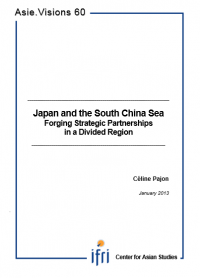Gateway to Think Tanks
| 来源类型 | Publications - Policy Papers - Asie Visions |
| 规范类型 | 简报 |
| DOI | 978-2-36567-126-2 |
| Japan and the South China Sea: Forging Strategic Partnerships in a Divided Region Asie.Visions, No. 60, January 2013 | |
| Céline PAJON | |
| 发表日期 | 2013-01-12 |
| 出处 | Asie Visions |
| 出版年 | 2013 |
| 概述 | In the midst of growing tensions with China, Japan is deepening its strategic engagement in Southeast Asia. Preserving stability in the South China Sea, which is threatened by renewed frictions around contested territories, is a vital interest for sea lane-dependent Japan. Moreover, Tokyo... |
| 摘要 |
Japan and the South China Sea: Forging Strategic Partnerships in a Divided Region Asie.Visions, No. 60, January 2013
In the midst of growing tensions with China, Japan is deepening its strategic engagement in Southeast Asia. Preserving stability in the South China Sea, which is threatened by renewed frictions around contested territories, is a vital interest for sea lane-dependent Japan. Moreover, Tokyo considers Southeast Asian countries as crucial partners in balancing against an increasingly powerful and more assertive China.  Therefore, Tokyo is stepping up its security cooperation in the region through the promotion of regional maritime and security institutions, but more importantly, by building strategic partnerships and helping to foster the maritime capacities of key like-minded countries (notably Indonesia, the Philippines and Vietnam). These initiatives augment the “great game” of influence currently underway in Southeast Asia and in which Japan is soft-balancing China and supporting a more sustainable US presence. Still, forging strategic partnerships is not an easy task as ASEAN countries, if increasingly polarized, are not passive in the face of the great powers contest. As East Asia grows seemingly more divided and as a competition for influence is flaring up, Europe is politically absent. Yet, expectations for more politico-military involvement from European countries in the region do exist, especially in Japan. If discussions about a possible “EU pivot” to East Asia are developing, many obstacles and limitations still constrain an expansion of European influence in the region.
Japan and the South China Sea: Forging Strategic Partnerships in a Divided Region
|
| 关键词 | strategy ASEAN China Japan South China Sea United States |
| URL | https://www.ifri.org/en/publications/enotes/asie-visions/japan-and-south-china-sea-forging-strategic-partnerships-divided |
| 来源智库 | French Institute of International Relations (France) |
| 引用统计 | |
| 资源类型 | 智库出版物 |
| 条目标识符 | http://119.78.100.153/handle/2XGU8XDN/415704 |
| 推荐引用方式 GB/T 7714 | Céline PAJON. Japan and the South China Sea: Forging Strategic Partnerships in a Divided Region Asie.Visions, No. 60, January 2013. 2013. |
| 条目包含的文件 | ||||||
| 文件名称/大小 | 资源类型 | 版本类型 | 开放类型 | 使用许可 | ||
| av60.png(28KB) | 智库出版物 | 限制开放 | CC BY-NC-SA |  浏览 | ||
| asievisions60celinep(813KB) | 智库出版物 | 限制开放 | CC BY-NC-SA | 浏览 | ||
除非特别说明,本系统中所有内容都受版权保护,并保留所有权利。